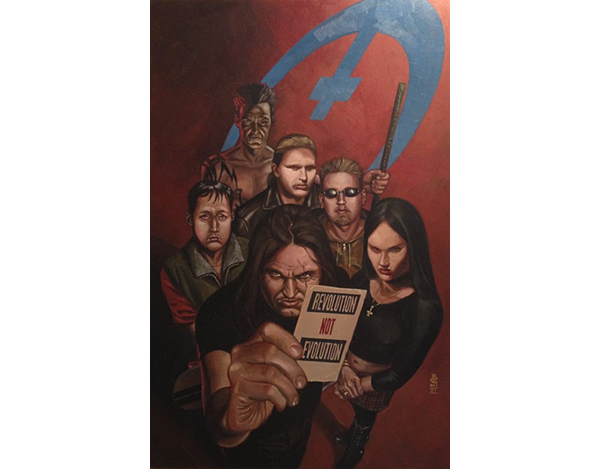 Motto: Revolution not Evolution
Motto: Revolution not Evolution
BEFORE
- At an unspecified moment in time, three mutants (Hoffman, Marshal and Orwell) formed a terrorist group called “The Brotherhood.” Over time, the group expanded to having cells in several places, such as London, Bangkok, the Brazilian jungle, Rome, New York, Philadelphia, Moscow, Brazil, Tokyo and Bogota. The Brotherhood would leave a notarized letter at the scene of their crimes to let the public know it was them. Various incarnations of the Brotherhood of Evil Mutants, later the Brotherhood of Mutants, had existed as a counterpoint to the X-Men over the years. All at least cl
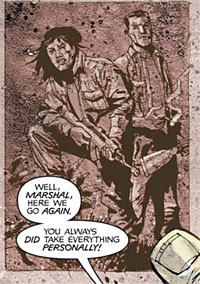 aimed to be fighting for the liberation of the mutant race from their “human oppressors.” While this group was unaffiliated with the others, it seems minimally from a branding perspective that they took inspiration from their predecessors by using a similar name.
aimed to be fighting for the liberation of the mutant race from their “human oppressors.” While this group was unaffiliated with the others, it seems minimally from a branding perspective that they took inspiration from their predecessors by using a similar name. - Marshal and Hoffman cut ties five years before the events of Brotherhood #1. Marshal then infiltrated the United States government, working his way up, though he remained loyal to the cause secretly.
- Orwell felt that, despite Hoffman's blatant narcissism, his charisma was useful for recruitment purposes. He hoped to secretly manipulate him and maintained his working relationship with Marshal in secret.
- A mutant genocide had occurred on Genosha with 16 million residents murdered by Sentinels. Magneto, the founder of the original Brotherhood, was also believed killed. [New X-Men (1st series) #115] In the aftermath, other positive events had occurred, though. Charles Xavier's school had gone public, there were now mutant celebrities like X-Force/X-Statix and smaller mutant communities like Mutant Town in New York and Valle Soleda in California had formed. It was truly a time of extremes for the mutant race. [New X-Men (1st series) #116, X-Force (1st series) #117, New X-Men (1st series) #127, X-Treme X-Pose #1]
CHRONOLOGY
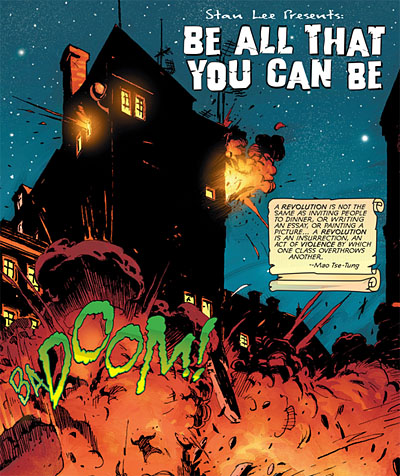 Hoffman and Orwell waited in the shadows as one of their newer recruits, Oswald, a reluctant young man, used his powers to destroy a Moscow nightclub, killing hundreds. It was a brutal act that had cemented Oswald's place in their cause, though he remained conflicted about it.
Hoffman and Orwell waited in the shadows as one of their newer recruits, Oswald, a reluctant young man, used his powers to destroy a Moscow nightclub, killing hundreds. It was a brutal act that had cemented Oswald's place in their cause, though he remained conflicted about it.
Afterward, the two men journeyed to Brooklyn to observe a prospective recruit – Michael Asher. Unaware of his mutation, Asher was more preoccupied with trying to get his girlfriend, Kary, to sleep with him than with any thoughts of civil rights or mutants causes. To make contact with him, they sent Fagin, one of their members who, though not much older than Asher, at least looked the part of a teenager. Fagin quickly befriended Asher and the two skipped class, indulging in petty crime as a way to bond. Throughout the day, Fagin subtly hinted at their shared mutant status, but Asher remained clueless, focused solely on his own life. By chance, they witnessed a mutant-bashing in New York, where a non-human man was being accosted by a group of attackers. Without hesitation, Fagin jumped in to defend the victim, revealing to Asher that he, too, was a mutant. Asher, still processing this revelation, was struck dumb. But the situation took a turn when Fagin was hit from behind. Hoffman then revealed himself and seemed to telepathically calm the attackers, allowing the victim to flee. As the chaos subsided, Hoffman extended an offer to the confused Asher, inviting him to join their cause and begin his indoctrination into the Brotherhood. Meanwhile, Fagin tossed the Brotherhood's calling card to the rioters, a final gesture before Oswald appeared nearby and, in a flash, obliterated the attackers and their surroundings in an explosion.
[Note: The mutant bashing could have been staged and the violent humans telepathically influenced. The timing of everything seemed a little too convenient.]
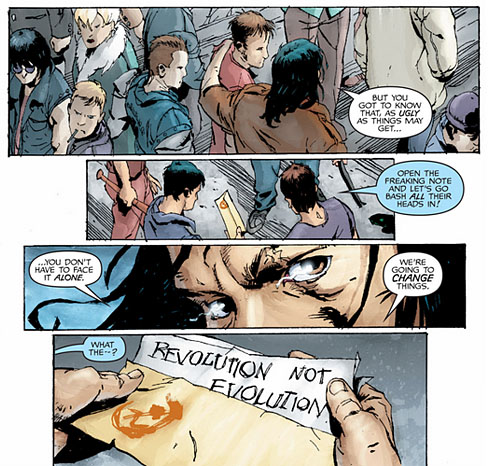 The Brotherhood's high-profile crimes had not escaped notice. The United States government was hunting them and successfully found their cell in Bogota, Colombia, though one female member (unnamed) of the Brotherhood managed to kill most of the task force that was hunting her at the same time. Her own fate is unclear. The surviving soldiers were taken back to Louisiana for treatment but one of them was a Brotherhood plant who blew himself up, killing General Hammond, who was in charge of the operation. In the aftermath, Marshal, former member of the Brotherhood now a government agent, took over the investigation.
The Brotherhood's high-profile crimes had not escaped notice. The United States government was hunting them and successfully found their cell in Bogota, Colombia, though one female member (unnamed) of the Brotherhood managed to kill most of the task force that was hunting her at the same time. Her own fate is unclear. The surviving soldiers were taken back to Louisiana for treatment but one of them was a Brotherhood plant who blew himself up, killing General Hammond, who was in charge of the operation. In the aftermath, Marshal, former member of the Brotherhood now a government agent, took over the investigation.
Asher was still in shock, unable to join the group. Believing that the harsh realities of their world would soon push him toward their cause anyway, they decided to send him home. Meanwhile, Hoffman and Orwell set out for Colombia to investigate whether the group had a mole who had tipped off the US government, leading to the attack. Fagin stayed behind to keep an eye on Asher, and it proved to be the right choice. Asher took the revelation of his mutation poorly, sinking further into despair. His situation only worsened when he yet again became the target of the school bully and his girlfriend, Kary, told him she wanted to wait. Humiliated by the bully, Asher's plight caught the attention of two other students in his class, both victims of bullying themselves. They offered him a fragile olive branch, but it quickly soured when they revealed they had been stockpiling weapons with the intent to massacre the school. Dejected by the fact that now a second group of terrorists were reaching out to him, Asher, already broken, confessed that he was a mutant. The two boys recoiled in fear, fleeing from him in terror. In his desolation, Asher attempted to take his own life. However, just as he was about to end it all, Fagin appeared and stopped him. He reminded Asher that being a mutant wasn't a death sentence – it was an opportunity. He had power now, though he hadn’t even begun to understand it. Why end his life before discovering what he could become?
Fagin then took Asher to a nightclub in Lower Manhattan, a gathering spot for mutants and mutant hopefuls. Among the crowd was Marabeth, another member of the Brotherhood. The two hit it off instantly and, before the night ended, Asher found himself with Marabeth, losing his virginity. The connection he shared with her deepened his bond with the Brotherhood, giving him a new sense of belonging and purpose.
Hoffman and Orwell had captured a member of the Brotherhood whom Orwell convinced Marshal was a traitor. Fueled by this belief, Hoffman subjected the captured man to brutal torture, determined to extract a confession, completely unaware that it was Orwell himself who was the traitor.
Asher returned home and his father, sensing something was wrong, attempted to bond with him on the drive to school but Asher was stone-faced. When he arrived at school, his bully, Joey, boasted about sleeping with Kary. An enraged Asher lunged at Joey but was no match for him. Thankfully, he was saved again by Fagin. Later that day, there was mandatory HIV testing going on in the school. Fagin explained this was a smokescreen and they were actually testing for mutants. When Asher observed the two outcast students appearing to be going for their weapon's cache, he stopped his own blood test. He tried to warn the principal about the gunmen but it was just perceived that his strange behavior was due to him being a mutant. Being held down by seemingly federal officers, Asher confessed he was indeed a mutant but that they needed to listen to him now or they would all die. He managed to wriggle free and got a call into his parents, telling them he loved them and begging them not to come to school, as he knew something horrible was about to happen. While sneaking around, he came across a tearful Kary and found out she had actually been drugged and raped by the school bully.
Soon Hoffman and Orwell appeared behind Asher and he lashed out. He wanted to save the other students but needed to know what his powers really were so but they refused to tell him. Hoffman thought this moment was teachable and left Asher to his own devices while he found Jo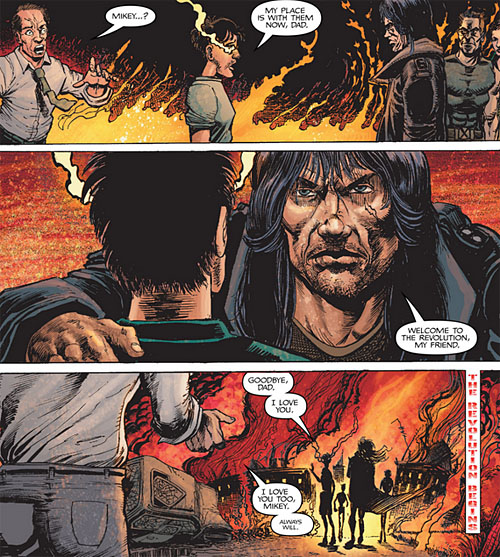 ey and Asher's father, who had ignored what his son said and arrived at the school anyway. Meanwhile, Mari and Fagin had already found the gunmen and Mari had killed them before they could start any violence. Asher was horrified. He was concerned with preserving lives and didn't want to kill anyone. He had had already pulled the fire alarm to try and get the school clear. Mari told him that, if she were wearing a uniform, given the loss of life she had just prevented, she would be classed as a hero. She also mentioned that they had sex, just as Kary appeared behind him with Joey and Asher's father, herded there by Hoffman. Kary quickly rejected Asher, disgusted he was a mutant and even thinking her prior attraction to him might have been the result of him using a mutant power on her. Surprisingly, despite his anti-mutant sentiments earlier, Asher's father was very clear he still loved his son and would accept him no matter what. Asher was placed with a choice between his old life and new. In part due to his worry about the danger he could bring on to his own family, Asher chose the Brotherhood. His powers finally manifested. He was able to control and detonate his own blood, which he used to destroy the blood testing truck outside. He left with the Brotherhood, while he and his father professed their continued love for each other. [Brotherhood #1-3]
ey and Asher's father, who had ignored what his son said and arrived at the school anyway. Meanwhile, Mari and Fagin had already found the gunmen and Mari had killed them before they could start any violence. Asher was horrified. He was concerned with preserving lives and didn't want to kill anyone. He had had already pulled the fire alarm to try and get the school clear. Mari told him that, if she were wearing a uniform, given the loss of life she had just prevented, she would be classed as a hero. She also mentioned that they had sex, just as Kary appeared behind him with Joey and Asher's father, herded there by Hoffman. Kary quickly rejected Asher, disgusted he was a mutant and even thinking her prior attraction to him might have been the result of him using a mutant power on her. Surprisingly, despite his anti-mutant sentiments earlier, Asher's father was very clear he still loved his son and would accept him no matter what. Asher was placed with a choice between his old life and new. In part due to his worry about the danger he could bring on to his own family, Asher chose the Brotherhood. His powers finally manifested. He was able to control and detonate his own blood, which he used to destroy the blood testing truck outside. He left with the Brotherhood, while he and his father professed their continued love for each other. [Brotherhood #1-3]
The London cell was dispatched to kidnap heiress Malon Reeves. She was a closet mutant, like her father Malcom, a well-known media mogul. Marshal wanted her kidnapped in exchange for ransom to fund their cause. Four members of the Brotherhood attempted to capture Malon from the Reeves estate, though she managed to evade and even fatally injure one of their group, the flier named Clive. She reached London and went to a nightclub she frequented, hoping to hide within the crowd. The three remaining members of the cell, Bela, Fiona and Bryson Bale, tracked her down and killed some of her friends while she fled to alley outside. Terrified, she finally used her own powers injuring Fiona and Bela, the latter of which would retain a grudge against her. Some of her father's men appeared nearby but were no match for the Brotherhood and Malon was kidnapped. [Brotherhood #4]
Bela, a psionic vampire, was especially brutal to Malon during her captivity, much to revulsion of Bale. It proved too much for him and he intervened and decked Bela, making it clear that his abuse of Malon was to stop. Malon observed this through a crack in her cell, her eyes full of tears. Bale's threat worked and Bela eased off, besides both he and Fiona were soon dispatched back to the Reeves estate to attempt to kill Marshal, who was investigating Malon's disappearance. After a failed assassination attempt, both Bela and Fiona were captured by Marshal, who viciously tortured both of them to try to get information from them about the identity of the Brotherhood's leader, “X.” Their fates are unknown but likely deceased.
[Note: It seemed likely that Orwell tipped off Marshal and deliberately sent Fiona and Bela to their deaths. Further, given the revelation by Brotherhood #9 that Marshal knew who “X” was the entire time, his entire investigation was an act and he may have been torturing Fiona and Bela for fun or to remove them later on as loyalists to Hoffman.]
Bale had a change of heart. The treatment of Malon had not sat right with him. After all, she was one of them, so he opted to change tact and try to recruit Malon instead of keeping her a prisoner. 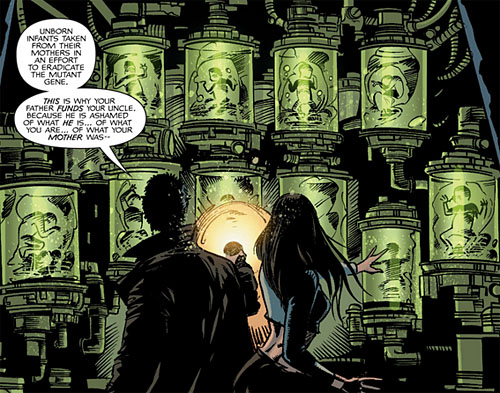 He took her to Paris to visit her “uncle” Peri's clinic. He felt she needed to know how her father spent and made his money. The “Peri Clinique” was a laboratory hoping to find a cure of mutants. Horrific experiments took place there and many mutants had been killed. One room full of preserved mutant fetuses was particularly disturbing for Malon. When they found Peri himself, Bale told Malon that his experiments had even led to the death of Malon's mother. Furious, Malon burned the clinic to the ground, presumably along with Peri. The whole affair bonded Malon and Bale together, both feeling like the other had finally given them purpose and “human” connection, which they had been lacking. [Brotherhood #5]
He took her to Paris to visit her “uncle” Peri's clinic. He felt she needed to know how her father spent and made his money. The “Peri Clinique” was a laboratory hoping to find a cure of mutants. Horrific experiments took place there and many mutants had been killed. One room full of preserved mutant fetuses was particularly disturbing for Malon. When they found Peri himself, Bale told Malon that his experiments had even led to the death of Malon's mother. Furious, Malon burned the clinic to the ground, presumably along with Peri. The whole affair bonded Malon and Bale together, both feeling like the other had finally given them purpose and “human” connection, which they had been lacking. [Brotherhood #5]
Now fully committed to the Brotherhood and madly in love with Bale, Malon released a video, condemning her father and threatening to expose his secrets. She and Bale also went on a crime spree, 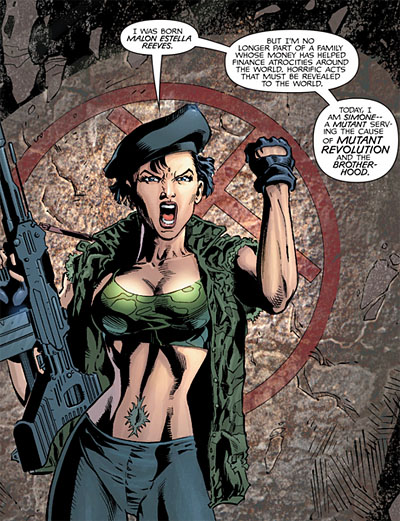 destroying Reeves' facilities across the UK. Fagin and Asher had been sent to meet up with Bale and Malon and they were all hiding out in a village in Cornwall, called Tintagel. Malcom had taken his daughter's threats very seriously and dispatched his own men to find and kill her; to him his secret was worth more than her life. The veteran Bale managed to get the three out of harm’s way. Back in London, yet again in hiding, Bale gave Asher and Fagin some money and told them to flee, specifically telling Asher to return to his family and forgot about the Brotherhood. Asher and Fagin walked into the London fog, seemingly accepting what Bale had suggested. He told Malon it was time for them to disappear too, but she couldn't until she confronted her father. The lovers sneaked into the Reeves headquarters. Malon admonished her father until he finally confessed he too was a mutant. A vicious brawl broke out between father and daughter, but Bale yet again intervened for Malon. Attempting to save his love, he jumped from the skyscraper, holding Malcolm, both dying when they hit the ground. Malon, Asher and Fagin were all soon found by Marshal who imprisoned them. [Brotherhood #6]
destroying Reeves' facilities across the UK. Fagin and Asher had been sent to meet up with Bale and Malon and they were all hiding out in a village in Cornwall, called Tintagel. Malcom had taken his daughter's threats very seriously and dispatched his own men to find and kill her; to him his secret was worth more than her life. The veteran Bale managed to get the three out of harm’s way. Back in London, yet again in hiding, Bale gave Asher and Fagin some money and told them to flee, specifically telling Asher to return to his family and forgot about the Brotherhood. Asher and Fagin walked into the London fog, seemingly accepting what Bale had suggested. He told Malon it was time for them to disappear too, but she couldn't until she confronted her father. The lovers sneaked into the Reeves headquarters. Malon admonished her father until he finally confessed he too was a mutant. A vicious brawl broke out between father and daughter, but Bale yet again intervened for Malon. Attempting to save his love, he jumped from the skyscraper, holding Malcolm, both dying when they hit the ground. Malon, Asher and Fagin were all soon found by Marshal who imprisoned them. [Brotherhood #6]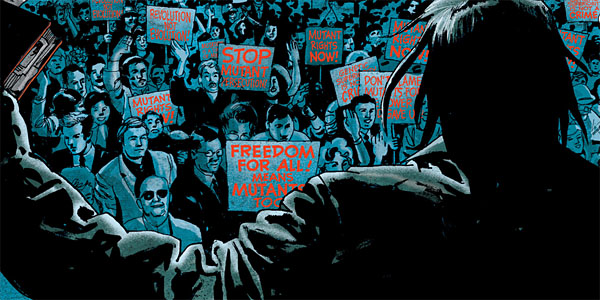 Hoffman was distraught at the loss of London Cell. He and Orwell decided to escalate their plans. They summoned members of the Brotherhood from all over the world for a rally in Philadelphia (the building was not identified but looked to the Philadelphia Museum of Art). Hoffman spoke to them like a messianic figure, comparing himself to Martin Luther King, Gandhi and Robert Kennedy but, unlike them, he made it clear even to his followers, he intended to live. As riot police arrived to try and apprehend him, he whipped the crowd into a frenzy and told them to attack. It was brutal and made the international news. He sneaked off through the sewers, gleeful with the strife he had just instigated. Orwell found him in a bar chatting up a human woman. The mute telepath made it known he was again furious with him; even undercover Orwell was struggling to hide his growing disdain for Hoffman. After a patron figured out who Hoffman was, he torched the bar and he and Orwell left, seemingly killing everyone present.
Hoffman was distraught at the loss of London Cell. He and Orwell decided to escalate their plans. They summoned members of the Brotherhood from all over the world for a rally in Philadelphia (the building was not identified but looked to the Philadelphia Museum of Art). Hoffman spoke to them like a messianic figure, comparing himself to Martin Luther King, Gandhi and Robert Kennedy but, unlike them, he made it clear even to his followers, he intended to live. As riot police arrived to try and apprehend him, he whipped the crowd into a frenzy and told them to attack. It was brutal and made the international news. He sneaked off through the sewers, gleeful with the strife he had just instigated. Orwell found him in a bar chatting up a human woman. The mute telepath made it known he was again furious with him; even undercover Orwell was struggling to hide his growing disdain for Hoffman. After a patron figured out who Hoffman was, he torched the bar and he and Orwell left, seemingly killing everyone present.
The riot in Philadelphia was beneficial to Marshal, who managed to flip Asher, Malon and Fagin to his side, seeing how reckless Hoffman had become. Malon and Asher, in particular, were disgusted and wanted revenge for what they had lost. It was agreed that Marshal would fake a jailbreak for the three and they would return to Hoffman, so they could inform and hopefully get the madman imprisoned. [Brotherhood #7]
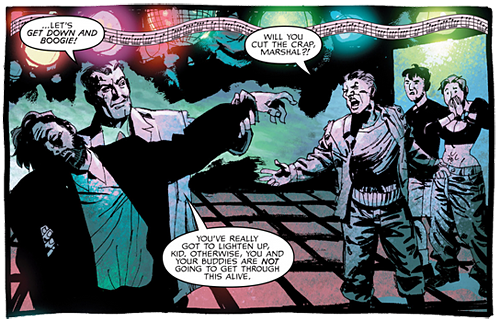 Hoffman's Philadelphia stunt attracted a lot of unwanted attention. The X-Men were going after the North American cells, Charles Xavier was exposing their secret agents and Cable and X-Force had wiped out their Brazilian and Toyko cells respectively. Hoffman feigned happiness when Asher, Malon and Fagin found him in Manhattan, though he did not trust them. He sent them on a mission to assassinate a member of their group, Dick/Jane Smythe, who he said had leaked information to the government. Realizing that Hoffman was on to them, the trio had no choice but to reach out to Marshal again. Any doubt they had he was just as bad, as Hoffman went away when he theatrically waltzed with a corpse which he intended them to switch with their intended target. The plan worked and they managed to knock Smythe out cold, replacing him/her with the double and Asher used his blood to blow up Smythe's apartment. Marshal then took Smythe into custody. Disturbingly, he cut off one of her hands to give the trio as proof of her death to Hoffman. Still not sold on their allegiance, as he knew how crafty Marshal was, he simply pretended to the young mutants he considered them loyal and told them of his latest scheme. He wanted to strike at the heart of the mutant collaborators and was targeting the celebrity mutants of X-Force. They were due to have a parade in New York and he wanted to kill Doop, specifically who he saw him as the heart of the team and a symbol for mutant sell-outs. [Brotherhood #8]
Hoffman's Philadelphia stunt attracted a lot of unwanted attention. The X-Men were going after the North American cells, Charles Xavier was exposing their secret agents and Cable and X-Force had wiped out their Brazilian and Toyko cells respectively. Hoffman feigned happiness when Asher, Malon and Fagin found him in Manhattan, though he did not trust them. He sent them on a mission to assassinate a member of their group, Dick/Jane Smythe, who he said had leaked information to the government. Realizing that Hoffman was on to them, the trio had no choice but to reach out to Marshal again. Any doubt they had he was just as bad, as Hoffman went away when he theatrically waltzed with a corpse which he intended them to switch with their intended target. The plan worked and they managed to knock Smythe out cold, replacing him/her with the double and Asher used his blood to blow up Smythe's apartment. Marshal then took Smythe into custody. Disturbingly, he cut off one of her hands to give the trio as proof of her death to Hoffman. Still not sold on their allegiance, as he knew how crafty Marshal was, he simply pretended to the young mutants he considered them loyal and told them of his latest scheme. He wanted to strike at the heart of the mutant collaborators and was targeting the celebrity mutants of X-Force. They were due to have a parade in New York and he wanted to kill Doop, specifically who he saw him as the heart of the team and a symbol for mutant sell-outs. [Brotherhood #8]
[Note: Possibly his targeting of X-Force was due to their massacre of the Toyko cell, which he referred to as the pride of the organization. Ironically, Doop isn't even a mutant, he's an alien.]
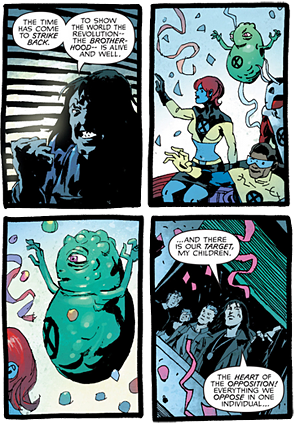 Hoffman sent them out into the crowd, letting them know other scattered members of the movement were hiding, ready to help them. He remarked to Orwell that he would have died for these children, had they not betrayed him so quickly to Marshal. As they were leaving, Asher remarked that he had told Marshal of Hoffman's plan already. Fagin questioned what their exit strategy was and, when it was clear Marshal hadn't mentioned one, he knew they were patsies for both sides. The three decided that their best chance for survival was to try to tip X-Force off when they were passing them. This had been predicted and Orwell telepathically commanded a member of the group, Chela, to attack X-Force, just as he was standing next to Asher, Malon and Fagin. Other members of the Brotherhood sprung from the crowd and the three were in the center of a battle. X-Force weren't really heroes, they just played heroes on TV, and they took down their attackers with an unexpected ferocity. Malon and Fagin felt they had no choice but to try to fight their way out, but both seemed to be killed quite quickly. Asher was shocked; he had a been a fan of X-Force and even had a crush on U-Go Girl in the past. During his time lusting over her, it never would have occurred to him that she would ultimately be the one responsible for his demise, as she teleported him into the sky and dropped him onto a car, causing fatal injuries.
Hoffman sent them out into the crowd, letting them know other scattered members of the movement were hiding, ready to help them. He remarked to Orwell that he would have died for these children, had they not betrayed him so quickly to Marshal. As they were leaving, Asher remarked that he had told Marshal of Hoffman's plan already. Fagin questioned what their exit strategy was and, when it was clear Marshal hadn't mentioned one, he knew they were patsies for both sides. The three decided that their best chance for survival was to try to tip X-Force off when they were passing them. This had been predicted and Orwell telepathically commanded a member of the group, Chela, to attack X-Force, just as he was standing next to Asher, Malon and Fagin. Other members of the Brotherhood sprung from the crowd and the three were in the center of a battle. X-Force weren't really heroes, they just played heroes on TV, and they took down their attackers with an unexpected ferocity. Malon and Fagin felt they had no choice but to try to fight their way out, but both seemed to be killed quite quickly. Asher was shocked; he had a been a fan of X-Force and even had a crush on U-Go Girl in the past. During his time lusting over her, it never would have occurred to him that she would ultimately be the one responsible for his demise, as she teleported him into the sky and dropped him onto a car, causing fatal injuries.
[Note: Contextually, it appears Fagin was killed... However, based on how he was slashed, it is conceivable he could have survived.]
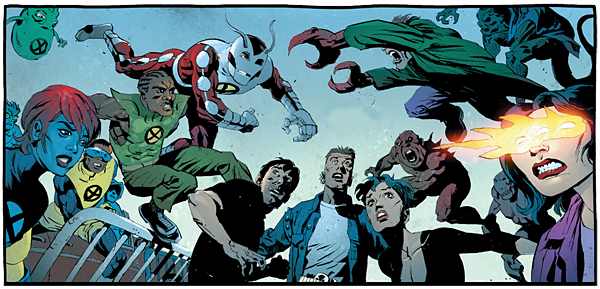 Meanwhile Marshal had been captured by Ms. Fingers, one of Hoffman's remaining loyal lieutenants. Orwell struck her from behind, seemingly killing her too. Marshall revealed the truth to Hoffman that he and Orwell had remained in collaboration with each for years. Orwell had convinced Marshal not to have Hoffman killed, thinking he had some use as a “face” but that time had passed now. They had manipulated this
Meanwhile Marshal had been captured by Ms. Fingers, one of Hoffman's remaining loyal lieutenants. Orwell struck her from behind, seemingly killing her too. Marshall revealed the truth to Hoffman that he and Orwell had remained in collaboration with each for years. Orwell had convinced Marshal not to have Hoffman killed, thinking he had some use as a “face” but that time had passed now. They had manipulated this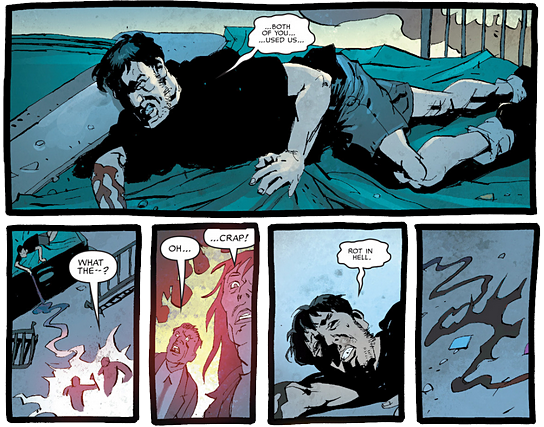 whole affair to have Hoffman killed and blame X-Force. In death, he would become a martyr and Hoffman would secretly replace him down the road as the new “X,” using his government connections to replenish soldiers for the movement and weed out of the weak. Hoffman would not go down without a fight and lashed out with his electric powers killing Orwell. As these two monumental narcissists went mano a mano, Asher was nearby, still clinging to life, hearing everything. Wanting them punished for all the hurt they had caused, with the last of his strength, he used his blood to incinerate them before passing away. In the aftermath, X-Force found all their bodies and their leader, Orphan, asked if anyone knew what had just happened. Ugo Girl suggested, “the end of a revolution?” [Brotherhood #9]
whole affair to have Hoffman killed and blame X-Force. In death, he would become a martyr and Hoffman would secretly replace him down the road as the new “X,” using his government connections to replenish soldiers for the movement and weed out of the weak. Hoffman would not go down without a fight and lashed out with his electric powers killing Orwell. As these two monumental narcissists went mano a mano, Asher was nearby, still clinging to life, hearing everything. Wanting them punished for all the hurt they had caused, with the last of his strength, he used his blood to incinerate them before passing away. In the aftermath, X-Force found all their bodies and their leader, Orphan, asked if anyone knew what had just happened. Ugo Girl suggested, “the end of a revolution?” [Brotherhood #9]
AFTER
- None of the Brotherhood have reappeared. Possibly, some may have been resurrected during the Krakoan age. Asher (maybe Fagin?) for example as a teenage mutant may have been prioritized for revival by the Krakoan council as that would fit with an Emma Frost “agenda,” given her long standing focus on mutant children, though this is mere speculation.
CANCELLATION AND THE IDENTITY OF “X”
The Brotherhood was written by the writer “X.” This was part of a marketing campaign to drum up interest for a title featuring unknown characters by allowing readers to speculate about the mysterious writer. All kinds of names were being thrown around, most commonly Devin Grayson, who was best known at the time for her work on DC's Nightwing.
In 2018, it was officially revealed that “X” was Howard Mackie, known to X-Men circles for his cult Mutant X run, which focused on Havok being transported into a Gothic imagining of the Earth-616. The Brotherhood was a sales success. However, in the post 9-11 world, Mackie and Marvel were mutually unsettled by the subject matter and feared the title could be perceived as glamorizing terrorism. They made the mutual decision to end the book and this likely was the reason for the all the key members of the Brotherhood being wiped out by issue #9. For more on Mackie's thoughts on the Brotherhood, please see his interview with CBR.
In hindsight, Mackie's intent and even execution is very clear, and he certainly does not glamorize his subjects. The series highlights just how vulnerable and isolated people can be manipulated by charismatic psychopaths into doing horrible things that go against their own values. Unfortunately, as is seen in the series, the self-awareness that this manipulation has even occurred often comes far too late.
[https://www.cbr.com/marvel-writer-x-identity-revealed/]
LEADERSHIP
 X (Marvin Hoffman)
X (Marvin Hoffman)
First appearance: The Brotherhood #1
Last appearance: The Brotherhood #9 (incinerated by Michael Asher's blood)
Powers: psionically influence others, generate bio-electrical charges from his hands
Notes:
- Hoffman had a low opinion of both Charles Xavier and Magneto.
- The Brotherhood #8 implies that Marvin may have had a drinking problem.
- He was a textbook narcissistic sociopath.
 Marshal
Marshal
First appearance: The Brotherhood #2
Last appearance: The Brotherhood #9 (incinerated by Michael Asher's blood)
Powers: unrevealed
Notes:
- Strangely his powers were not revealed.
- He had a long running rivalry with Hoffman, which led to their split.
- He was easily the most sadistic character seen in the Brotherhood series and seemed to enjoy torturing people. This is only reinforced with the revelation at the end of the series that he was collaborating with Orwell the entire time and therefore didn't need information from anyone. Given his plan to take over the group down the road, possibly he was just killing Hoffman's loyalists under the premise of interrogation.
- He was smoking in nearly every panel and the inspiration for him may have been the “Smoking Man” from the X-Files, who was also a haggard government agent with a secret agenda.
 Orwell
Orwell
First appearance: The Brotherhood #1
Last appearance: The Brotherhood #9 (electrocuted by Hoffman)
Powers: communicates psionically, can download massive amounts of information into the minds of others
Notes:
- Missing an eye and unable to speak.
- Potentially the most dedicated to their cause, as he endured Hoffman's personality in close proximity for years, despite the fact that by the end of the series it was abundantly clear that he couldn't stand him.
MEMBERS
 Michael Asher
Michael Asher
First appearance: The Brotherhood #1
Last appearance: The Brotherhood #9 (fatally injured when dropped from a height by U-Go Girl teleportation portals)
Powers: supercharged blood that, once oxidized, can be directed by his mental commands and is highly volatile so that it can create violent explosive reactions
Notes:
- Asher was clearly intended to the POV character, at least in the first few issues. He was from Brooklyn and depicted as a typical teenager of the time, liked skateboards, Spider-Man and was desperate to lose his virginity.
- His father expressed serious anti-mutant sentiments and was in favor of mutant testing, though his mother was more moderate. However, despite all this, when his father realized he was a mutant, he made it clear he didn't reject him and loved him still.
- Asher seemed to the character we could have imagined as easily joining Xavier's school if he had been discovered by the X-Men first.
- He was a fan of X-Force and had a crush on U-Go Girl before she killed him.
 Fagin
Fagin
First appearance: The Brotherhood #1
Last appearance: The Brotherhood #9 (slashed by Vivisector)
Powers: heightened strength and reflexes, morph an exoskeleton structure over his skin which protect him from harm and extends dozens of razor pointed spikes from his body
Notes:
- He was wearing a “born to lose, live to win” jacket, which is a phrase associated with Motorhead's Lemmy Klimster. Presumably, he was a fan of the group, despite them being “flatscans.”
- Fagin's name is probably a nod to the character of the same name from the novel & musical Oliver. Fagin teaches Oliver about thievery in much the same way the Brotherhood's Fagin takes Asher under his wing.
- Fagin was Australian.
- He used recreational marijuana, which was still widely illegal at the time of publication.
 Malon Estella Reeves
Malon Estella Reeves
First appearance: The Brotherhood #4
Last appearance: The Brotherhood #9 (impaled by Spike)
Powers: emanate an energized mist from her hands that can disintegrate material upon contact
Notes:
- Malon was a second-generation mutant. One of the sub-plots of the title involved the public's concern that all children of mutants also became mutants, overtime, this would mean the human race would go extinct.
- A probable inspiration for this character is heiress Patty Hearst, who infamously developed Stockholm syndrome after being kidnapped by a group of terrorists.
- In most of her appearances she wore a bindi. Possibly, this was to indicate her unseen mother was of Indian origin. However, in the early ‘00s, the bindi was used often as a fashion accessory by western celebrities like Gwen Stefani and Bjork, therefore this leaves Malon's racial identity ambiguous.
- In The Brotherhood #6, she seemed to destroy a satellite using her powers, while she was still on Earth. A range like this for her blasts seems unlikely. This may have been artist error.
- According to her father, her mother was also a mutant but her powers were driving her insane. She died while her uncle “Peri” attempted to cure her.
- Her father had taught her to be ashamed of her powers, which she kept secret and only became aware of his after Bale outed him.
 Bryson Bale
Bryson Bale
First appearance: The Brotherhood #4
Last appearance: The Brotherhood #6 (fell to death from the Reeves skyscrapper)
Powers: superhuman strength, agility, and invulnerability
Notes:
- When Bryson's powers emerged, his house was burned down and his younger sister Tracy was killed. His mother died by suicide shortly after.
- Bale was another character who was not inherently evil. He had been inducted into the Brotherhood during a vulnerable time and was quite chivalrous towards the younger mutants in the sect. Again, he seemed to be another character who could have been an X-Man if found by the X-Men first.
 Bela (Tom Morgan)
Bela (Tom Morgan)
First appearance: The Brotherhood #4
Last appearance: The Brotherhood #6
Powers: heightened strength and agility, flight, dissipate the moisture found within human bodies, causing them to revert into dried-up husks
Notes:
- Bela was a vicious psychopath and likely joined the Brotherhood because he liked hurting people. The intent seemed to be to provide contrast to Bale, who had the opportunity for redemption and/or a different life if things had gone differently when he was younger.
- His name appears to be a reference to Bela Lugosi, who played Dracula in the 1931 move of the same name.
- His fate was not confirmed but it seems likely he was eventually killed by Marshal.
 Clive Vickers
Clive Vickers
First appearance: The Brotherhood #4
Last appearance: The Brotherhood #4 (run over by Malon and then eated by Bela)
Powers: self-propelled flight
Notes:
- He was hit by Malon's car and then eaten by Bela. Presumably, the moment was to hint at how formidable Malon was potentially as she later became the lead female character in the series.
 Fiona
Fiona
First appearance: The Brotherhood #4
Last appearance: The Brotherhood #5
Powers: manifest a pair of "hags", cell replicants who split off from her main body with enhanced strength, reaction time, and razor sharp talons
Notes:
• Fiona's fate was not confirmed, however it seems likely she too was killed by Marshal during torture.
 Oswald
Oswald
First appearance: The Brotherhood #1
Last appearance: The Brotherhood #1
Powers: generate disruptive surges that detonate the molecules of nearby matter
Notes:
- Oswald was a young recruit for the Brotherhood and was likely in his teens/early 20s. He apparently had a bad life prior to joining the Brotherhood and was viciously bullied.
- He referenced that “Russia was changing” and the implication was that, despite his western name, he was in fact Russian.
- Though he was a terrorist, he was uncomfortable with killing, noting the screams disturbed him when he blew up that nightclub in Moscow.
- He is one of the few members of the Brotherhood whose death was not shown. He may still be alive.
 Maribeth “Mari”
Maribeth “Mari”
First appearance: The Brotherhood #2
Last appearance: The Brotherhood #3
Powers: Intangibility, expand her own electrical field to others with potentially fatal consequences
Notes:
- Maribeth took Asher's virginity.
- In her apartment, she had a book on Karl Marx and Lenin. She also (presumably ironically) had a poster of David Hasselhoff.
- She spoke negatively about the X-Men and their private school. Presumably, she was intended to be working class or at least considered herself working class.
- She was very anti-drugs and scolded Fagin for his marijuana use.
- As the X-Men were hunting the North American cells, she may have been imprisoned. Her fate was not confirmed.
 Ms. Fingers
Ms. Fingers
First appearance: The Brotherhood #9
Last appearance: The Brotherhood #9 (head bashed in by Orwell)
Powers: Invisibility, tentacles
Notes:
- Loyal to Hoffman, captured Marshal for him.
 Trois
Trois
First appearance: The Brotherhood #9
Last appearance: The Brotherhood #9
Powers: Three eyes, optic blasts
Notes:
- She was a three-eyed mutant with some optic blast ability.
- Her name, meaning three in French, could indicate she was part of a French cell.
- As she could not pass for human, she was possibly considered more expendable, as she wsa useless for infiltration purposes.
- She was presumably killed by X-Force.
- Name revealed in a Marvel handbook.
 Chela
Chela
First appearance: The Brotherhood #9
Last appearance: The Brotherhood #9 (suffocated by Phat)
Powers: lobster claw like hands
Notes:
- His name Chela was a reference to his lobster claws.
- The one who started the attack on X-Force.
- As he could not pass for human. Possibly, he was considered more expendable as useless for infiltration purposes.
- Presumably, he was killed by X-Force.
- Name revealed in a Marvel handbook.

 Jane/Dick Smythe
Jane/Dick Smythe
First appearance: The Brotherhood #8
Last appearance: The Brotherhood #8
Powers: able to transform into a green “male” monster with enhanced strength named “Dick”
Notes:
- Jane had apparently betrayed the Brotherhood to the government but which department is unknown. Marshal claims it wasn't him. As suggested below, possibly it was Senator Niles, as the only notable government official seen in the series. Alternatively, she could have sold them out to the X-Men, who were investigating the North American cells.
- She and Dick seemed to view themselves as separate people.
- Her fate is unknown after Marshal's forces took her away. Possibly, he killed her too off-panel after cutting off her hand.
 Unnamed Colombian female
Unnamed Colombian female
First appearance: The Brotherhood #2
Last appearance: The Brotherhood #2
Powers: Pyrokinesis
Notes:
- Member of the Bogota Cell. She was being hunted by the United States government. They did find her but she killed the task force hunting her. Her fate is unclear but presumably she is dead.
- In her monologue translated from Spanish, she expressed anti-American sentiments. It seemed that the Brotherhood were mixing concepts around anti-American imperialism and class issues with mutant rights.
 Unnamed infiltrator male
Unnamed infiltrator male
First appearance: The Brotherhood #2
Last appearance: The Brotherhood #2
Powers: self-destruction
Notes:
- This man detonated himself after being retrieved from the Bogota massacre. Whether he had already infiltrated the army before the assault or snuck in later is unclear. The intent seemed to be to assassinate General Hammond, who at that point was leading the investigation into the Brotherhood.
 Unnamed tortured male
Unnamed tortured male
First appearance: The Brotherhood #3
Last appearance: The Brotherhood #3
Powers: unknown
Notes:
- This man was considered a traitor to the organization and was accused of working of the United States government. He was tortured to death by Hoffman. He claimed that Orwell had used his telepathy to read his mind and ascertain but as was later revealed Orwell was himself a traitor, this might have been a lie.
 Unnamed Philadelphian man
Unnamed Philadelphian man
First appearance: The Brotherhood #7
Last appearance: The Brotherhood #7
Powers: Unrevealed
Notes:
- He was the organizer of the rally in Philadelphia. Presumably, he was killed or imprisoned in the ensuing chaos.


 Unnamed New York rioters
Unnamed New York rioters
First appearance: The Brotherhood #9
Last appearance: The Brotherhood #9
Powers: Unrevealed
Notes:
- All were presumed killed by X-Force.
- Notably, they were all mutants with physical mutations. Possibly, they were considered more expendable due to their inability to pass as human and therefore useless for infiltration purposes.
ENEMIES
 Ross Ludlum
Ross Ludlum
First appearance: The Brotherhood #1
Last appearance: The Brotherhood #2
Powers: None
Notes:
- Ludlum was a TV personality who seemed to be based on the “cable news” archetype. He was very anti-mutant and pushing for blood tests in “public” schools, though he was very much against his own daughter being tested privately.
- Marshal had him brought in for questioning, as he said he believed he had a government source providing information to his show.
- His fate was never revealed and the story point was possibly dropped. However, with the later revelation that Marshal secretly remained loyal to the mutant cause, possibly he just had been killed off-panel? Another possibility is that Ludlum's arc was given to Malcolm Reeves and Malon, so they could reinforce the international nature of the Brotherhood by highlighting a cell in another country.

 Malcolm Reeves
Malcolm Reeves
First appearance: The Brotherhood #4
Last appearance: The Brotherhood #6 (pushed from his skyscrapper by Bale)
Powers: generate intense microwave radiation combined with plasma to create a burning energy effect of incredible heat and destructive power
Notes:
- Malcolm was a classic, self-hating mutant. His powers seemed to be totally unrelated to his success as a media mogul.
- He did see to have some love for his daughter but it was far below his own shame at his mutant status and his love for his money.
- He was financing a clinic in Paris to try to cure mutants, which had caused mass deaths.
- His wife was a mutant who wanted to go public. She died shortly after. The series plays fast and loose about whether or not this was truly accidental or not.
 Harold Silverman and Joel
Harold Silverman and Joel
First appearance: The Brotherhood #1
Last appearance: The Brotherhood #3 (killed by Maribeth)
Powers: None
Notes:
- The creation of the two gunmen from Asher's school was likely inspired by the real-life Columbine massacre in 1999, also conducted by two teenagers. At the time of publication, the phenomena surrounding school shootings was very much in the forefront of the public consciousness and far rarer. Both teens, it should be noted, were viciously picked on by their entire school and severely isolated, which according to the Journal of Pediatric Health Care is a common thread in the development of these shooters. It seems likely that Mackie had these characters in the story intentionally as mirrors to the Brotherhood themselves, whose members’ own experiences of ostracization made them malleable for manipulation by Hoffman into committing acts of violence at his behest.
OTHER CHARACTERS
 Catherine Niles
Catherine Niles
First appearance: The Brotherhood #2
Last appearance: The Brotherhood #2
Powers: None
Notes:
- Catherine Niles was a senator in the United States government who appeared on the Ross Ludlum show. She was in favor of mutant registration, though she at least claimed this was for their well-being/public good. Her position appeared to be similar to Iron Man during Civil War.
- As the only prominent government official seen in the series, she may have been intended to be Ludlum's government source and/or with whom Jane Smythe was communicating, neither of whom were ever revealed.
- Her political party was not revealed.
